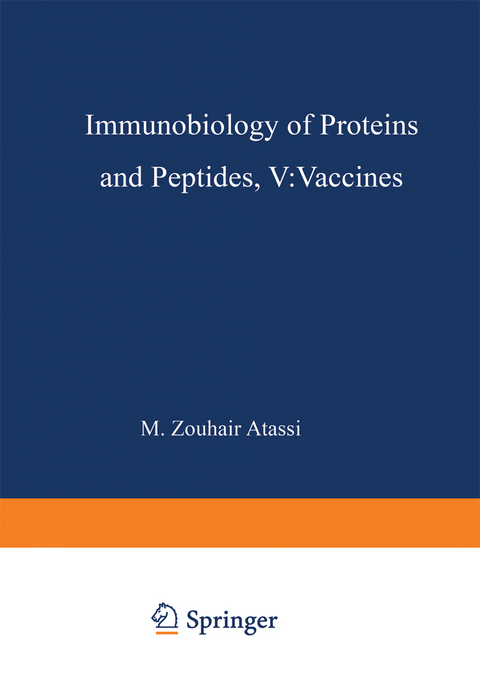
Immunobiology of Proteins and Peptides V
Springer-Verlag New York Inc.
978-1-4757-2048-8 (ISBN)
To achieve an intelligent and effective design of a vaccine, it is crucia1 to know a great deal about the immuno1ogy of infection and about the mechanism of action of the intended vaccine. Therefore many important papers dea1ing with the details of the humoral and ce11u1ar immune responses against the infective agents were presented. How to manipu1ate the immune system, either to maximize a required antibody or T-ce11 response or to reduce its magnitude is often desired in the design of an immuno1ogica1 defense strategy.
Content.- Developments Toward a Recombinant Pertussis Vaccine.- Prospects and Problems in Synthetic Vaccine Development: What did we Learn from the Cholera Toxin System?.- New Concepts in Vaccines for Mucosal Non-Enteric Human Bacterial Pathogens.- Stable Recombinant Avirulent Salmonella Vaccine Strains.- Cytotoxic and Helper T-Lymphocyte Responses to Antibody Recognition Regions on Influenza Virus Hemagglutinin.- Haemophilus b Oligosaccharide-CRM197 and Other Haemophilus b Conjugate Vaccines: A Status Report.- The Application of Molecular Biology to the Development of Novel Vaccines.- Studies on the Clonality of the Antibody Response to a Protein Epitope.- Anti-Idiotype Tumor Vaccines.- A VH Region Synthetic Peptide Induces Antibodies Which Bind Native Immunoglobulins and Augment an Immune Response to Antigen.- Enhancement of Primary and Secondary Immune Responses by Interferon-Gamma.- Interleukin 1 and It’s Synthetic Peptides as Adjuvants for Poorly Immunogenic Vaccines.- Protection Induced by Synthetic Peptides Corresponding to Three Serotypes in Foot and Mouth Disease Virus.- Characterization of a Synthetic Envelope Peptide of SRV-1 and SRV-2 Virus that Specifically Binds Rhesus Anti-SRV-1 and Anti-SRV-2 Neutralizing Antibodies.- Synthetic Peptide Representing a T-Cell Epitope of CRM197 Substitutes as Carrier Molecule in a Haemophilus Influenza Type B (HIB) Conjugate Vaccine.- The Use of Mouse Class II MHC Peptides to Produce Site-Specific Monoclonal Antibodies.- Epitope Mimicry by Anti-Idiotype Sequences in Reverse Orientation.- Vaccine-Containing Biodegradable Microspheres Specifically Enter the Gut-Associated Lymphoid Tissue Following Oral Administration and Induce a Disseminated Mucosal Immune Response.- Potential of Cell-Mediated Immune Responses DirectedAgainst P. Falciparum Sporozoite Peptide Vaccine by Immunomodulators.- Detoxification of Pertussis Toxin by Site-Directed Mutagenesis.- Filamentous Fusion Phage Cloning Vectors for the Study of Epitopes and Design of Vaccines.- Recombinant-Derived Modified-Live Herpesvirus Vaccines.- Advances in Understanding Structure-Function Relationships in Hepatitis B. Virus (HBV) Envelope (ENV) Proteins.- Antigenic Variation During Persistent Lentivirus Infections and its Implications for Vaccine Development.- Antigenic Structure of the Fusion Glycoprotein of Respiratory Syncytial Virus.- SIV Infected Rhesus Macaques: An AIDS Model for Immunoprevention and Immunotherapy.- The Development of Molecular Vaccines Against Malaria Sporozoites.- Developing a Gonococcal Protein I Vaccine.- The Genetics of the Immune Response to Trichinella spiralis Antigens in the Mouse.- Modulation of Antibody Responses by Conjugates of Antigens with Monomethoxypolyethylene Glycol.
| Zusatzinfo | 3 Illustrations, color; 51 Illustrations, black and white; XI, 356 p. 54 illus., 3 illus. in color. |
|---|---|
| Verlagsort | New York, NY |
| Sprache | englisch |
| Maße | 170 x 244 mm |
| Themenwelt | Studium ► Querschnittsbereiche ► Infektiologie / Immunologie |
| ISBN-10 | 1-4757-2048-3 / 1475720483 |
| ISBN-13 | 978-1-4757-2048-8 / 9781475720488 |
| Zustand | Neuware |
| Haben Sie eine Frage zum Produkt? |
aus dem Bereich


